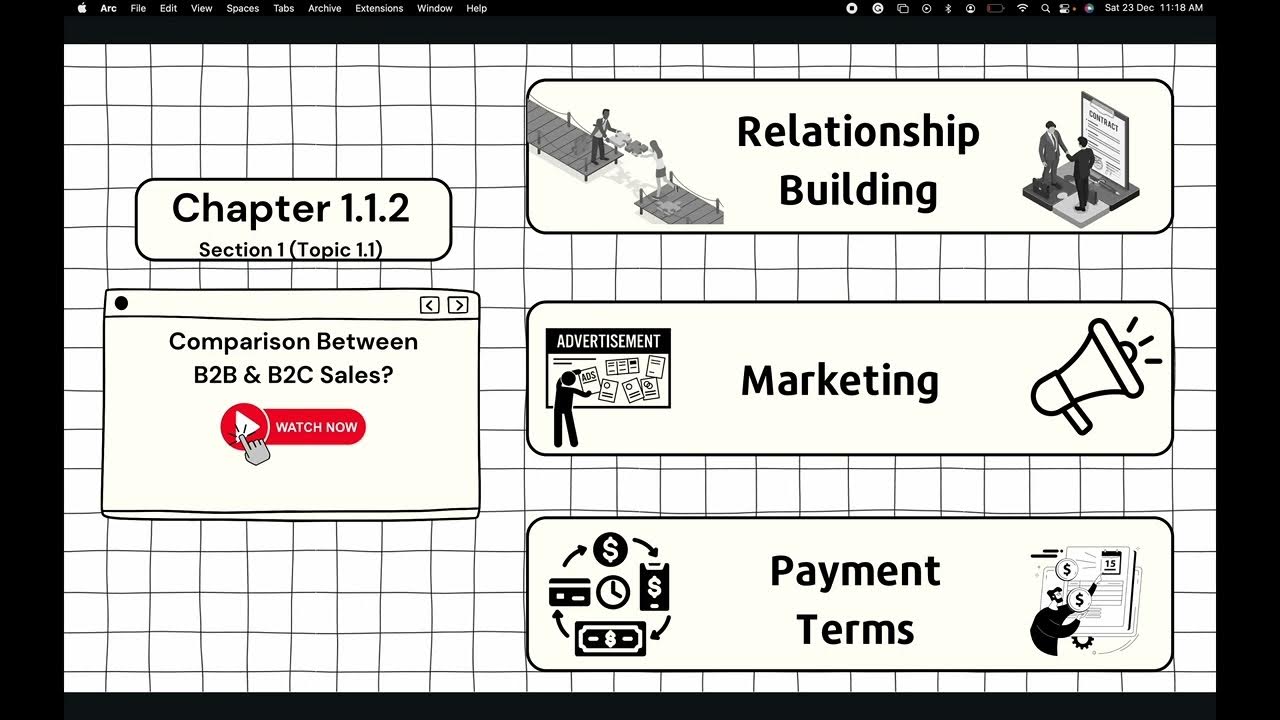B2B vs B2C Marketing (What Are The Differences?)
Summary
TLDRIn this episode of the Modern Marketing Show, Adam Erhart explores the contrasts between B2B and B2C marketing, emphasizing that both ultimately revolve around human connection. He critiques traditional marketing textbooks for their lack of real-world applicability and introduces H2H (Human to Human) marketing as a more effective approach. By focusing on authenticity, relatability, and genuine communication, marketers can foster better relationships and trust with their audience. Adam advocates for abandoning jargon and embracing a more human-centric strategy, which enhances marketing effectiveness and enjoyment.
Takeaways
- 😀 B2B (business to business) marketing focuses on selling products to other businesses, while B2C (business to consumer) marketing targets individual consumers.
- 😀 B2B typically involves fewer customers with larger, higher-value orders and longer decision-making processes, while B2C has more customers with smaller, lower-value transactions.
- 😀 Despite the differences, both B2B and B2C marketing share the common goal of solving customer problems through effective communication.
- 😀 The perception that B2B and B2C require entirely different marketing strategies is misleading; marketing fundamentally involves connecting with people.
- 😀 People prefer doing business with other people, not faceless corporations, emphasizing the importance of human connection in marketing.
- 😀 Today's consumers, whether in B2B or B2C contexts, are increasingly skeptical of traditional marketing tactics, making authenticity essential.
- 😀 H2H (human to human) marketing is an alternative that focuses on genuine, authentic communication rather than rigid business language.
- 😀 Emphasizing a conversational tone, relatable content, and genuine intentions can make marketing more effective and enjoyable.
- 😀 Authenticity in marketing does not compromise professionalism; it enhances the connection with the audience.
- 😀 Ultimately, in both B2B and B2C marketing, results are important, but prioritizing people and their needs leads to greater success.
Q & A
What are the primary differences between B2B and B2C marketing?
-B2B marketing typically involves fewer customers, larger orders, higher value transactions, longer decision-making times, and sustained relationships. In contrast, B2C marketing has more customers, smaller orders, lower transaction values, quicker purchasing decisions, and more transactional relationships.
Why does Adam Erhart emphasize the importance of human connection in marketing?
-Erhart highlights that regardless of whether it's B2B or B2C, people prefer to do business with other people rather than faceless corporations. This emphasizes the need for genuine, authentic interactions in marketing.
What challenges did Erhart face while learning about B2B marketing?
-He found traditional B2B marketing textbooks dull and filled with academic jargon that seemed disconnected from real-world applications, leading to a lack of engagement and understanding.
How does the concept of H2H marketing differ from traditional B2B and B2C marketing?
-H2H (Human-to-Human) marketing focuses on genuine, personal communication rather than corporate messaging. It emphasizes authenticity and the human experience, encouraging marketers to connect with their audience on a personal level.
What is the main goal of marketing, according to the video?
-The main goal of marketing is to communicate how a business, product, or service can solve the customer's problems, making it essential to focus on the customer's needs rather than complicating the process with unnecessary jargon.
What are some common traits of B2B industries?
-B2B industries generally have fewer customers, larger order sizes, higher transaction values, and longer decision-making processes compared to B2C industries.
What does Adam suggest as a better alternative to traditional marketing strategies?
-Adam suggests abandoning the constructs of B2B and B2C marketing in favor of H2H marketing, which focuses on genuine human connections and authentic communication.
How can authenticity in marketing impact audience perception?
-Authenticity can enhance audience trust and engagement. When marketers communicate genuinely, audiences are more forgiving of minor flaws and more willing to engage with the brand.
What are some key characteristics of effective marketing according to Erhart?
-Effective marketing should balance professionalism with approachability, remain authentic while engaging the audience, and prioritize people-driven interactions over purely results-driven approaches.
What resources does Adam Erhart provide for further learning about marketing?
-Erhart encourages viewers to visit his website, adamerhart.com, which offers various resources, articles, and videos to help enhance business and marketing strategies.
Outlines

このセクションは有料ユーザー限定です。 アクセスするには、アップグレードをお願いします。
今すぐアップグレードMindmap

このセクションは有料ユーザー限定です。 アクセスするには、アップグレードをお願いします。
今すぐアップグレードKeywords

このセクションは有料ユーザー限定です。 アクセスするには、アップグレードをお願いします。
今すぐアップグレードHighlights

このセクションは有料ユーザー限定です。 アクセスするには、アップグレードをお願いします。
今すぐアップグレードTranscripts

このセクションは有料ユーザー限定です。 アクセスするには、アップグレードをお願いします。
今すぐアップグレード関連動画をさらに表示

Facebook Shut Down Ad Account (Facebook Ad Account Disabled)

Digital Marketing 101 (A Beginner’s Guide To Marketing)

What is B2B Marketing? | From A Business Professor

Karakteristik dan Strategi Business to Business - Market Think #46

Creating a Content Marketing Strategy (Quality VS Quantity)

Comparison between B2B and B2C sales
5.0 / 5 (0 votes)
